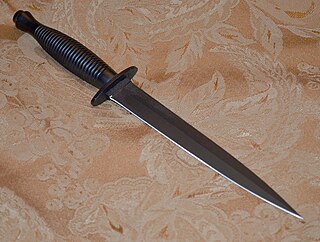
A dagger is a fighting knife with a very sharp point and usually one or two sharp edges, typically designed or capable of being used as a cutting or thrusting weapon. Daggers have been used throughout human history for close combat confrontations, and many cultures have used adorned daggers in ritual and ceremonial contexts. The distinctive shape and historic usage of the dagger have made it iconic and symbolic. A dagger in the modern sense is a weapon designed for close-proximity combat or self-defense; due to its use in historic weapon assemblages, it has associations with assassination and murders. Double-edged knives, however, play different sorts of roles in different social contexts.

A rapier or espada ropera is a type of sword originally used in Spain The name designates a sword with a straight, slender and sharply pointed two-edged long blade wielded in one hand. It was widely popular in Western Europe throughout the 16th and 17th centuries as a symbol of nobility or gentleman status.

A rondel dagger or roundel dagger is a type of stiff-bladed dagger used in Europe in the late Middle Ages, used by a variety of people from merchants to knights. It was worn at the waist and could be used as a utility tool, or worn into battle or in a jousting tournament as a side arm.
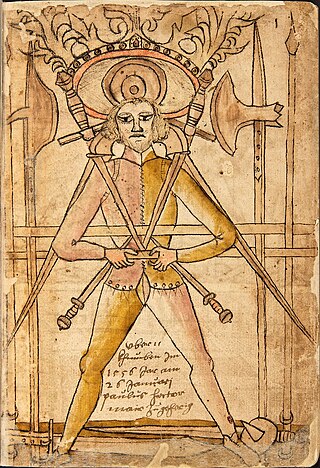
Historical European martial arts (HEMA) are martial arts of European origin, particularly using arts formerly practised, but having since died out or evolved into very different forms.

The English language terminology used in the classification of swords is imprecise and has varied widely over time. There is no historical dictionary for the universal names, classification, or terminology of swords; a sword was simply a single-edged or double-edged knife.
A dirk is a long-bladed thrusting dagger. Historically, it gained its name from the Highland dirk where it was a personal weapon of officers engaged in naval hand-to-hand combat during the Age of Sail as well as the personal sidearm of Highlanders. It was also the traditional sidearm of the Highland Clansman and later used by the officers, pipers, and drummers of Scottish Highland regiments around 1725 to 1800 and by Japanese naval officers.
A stiletto is a specialized dagger with a long slender blade and needle-like point, primarily intended as a thrusting and stabbing weapon.
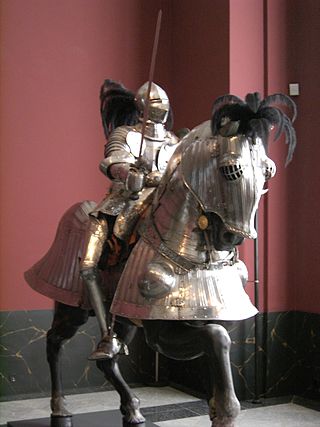
Barding is body armour for war horses. The practice of armoring horses was first extensively developed in antiquity in the eastern kingdoms of Parthia and Pahlava. After the conquests of Alexander the Great it likely made its way into European military practices via the Seleucid Empire and later Byzantine Empire. Though its historical roots lie in antiquity in the regions of what was once the Persian Empire, barded horses have become a symbol of the late European Middle Ages chivalry and the era of knights.

A bollock dagger or ballock knife is a type of dagger with a distinctively shaped hilt, with two oval swellings at the guard resembling male testes ("bollocks"). The guard is often in one piece with the wooden grip, and reinforced on top with a shaped metal washer. The dagger was popular in Scandinavia, Flanders, Wales, Scotland and England between the 13th and 18th centuries, in particular the Tudor period. Within Britain the bollock dagger was commonly carried, including by Border Reivers, as a backup for the lance and the sword. Many such weapons were found aboard the wreck of the Mary Rose. The bollock dagger is the predecessor to the Scottish dirk.
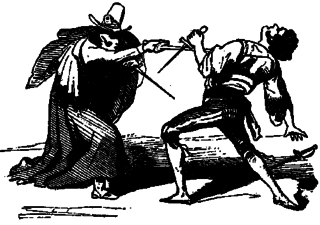
The parrying dagger is a category of small handheld weapons from the European late Middle Ages and early Renaissance. These weapons were used as off-hand weapons in conjunction with a single-handed sword such as a rapier. As the name implies they were designed to parry, or defend, more effectively than a simple dagger form, typically incorporating a wider guard, and often some other defensive features to better protect the hand as well. They may also be used for attack if an opportunity arises. The general category includes two more specific types, the swordbreaker and trident dagger.

The yoroi-dōshi (鎧通し), "armor piercer" or "mail piercer", is one of the traditionally made Japanese swords that were worn by the samurai class as a weapon in feudal Japan.
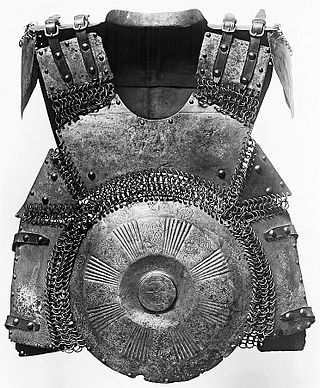
Mirror armour, sometimes referred to as disc armour or as chahār-āyneh or char-aina, was a type of cuirass used mainly in Asia, the Middle East, and Eastern Europe; including India, Persia, Tibet, Russia, and the Ottoman Empire. It literally translates to "four mirrors" which is a reflection of how these pieces looked, which resembles four metal discs or rectangular armour plates. Mirror armor was used in some cultures up to the 20th century.
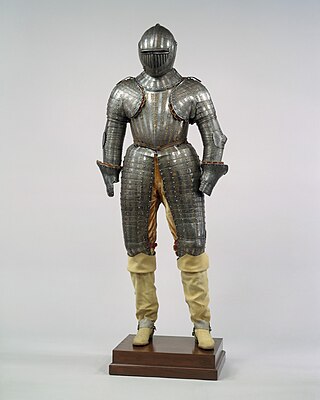
Munition armour was mass-produced armour stockpiled in armouries to equip both foot soldiers and mounted cuirassiers.

The basket-hilted sword is a sword type of the early modern era characterised by a basket-shaped guard that protects the hand. The basket hilt is a development of the quillons added to swords' crossguards since the Late Middle Ages. This variety of sword is also sometimes referred to as the broadsword, though this term may also be applied loosely and imprecisely to other swords.

The Swiss degen was a short sword, an elongated version of the Swiss dagger, with the same double-crescent shape of the guard. It was used as a type of side arm in the Old Swiss Confederacy and especially by Swiss mercenaries, from the first half of the 15th century until the mid 16th century. The native term used in the 15th century for this weapon was baselard. The term Schweizerdegen is first attested in 1499.

The Royal Armoury of Madrid or Real Armería de Madrid, is a collection that, among many other things, contains the personal arms of the Kings of Spain, and also houses military weapons, armours and diplomatic works of art like mixed tapestries, paintings and other works of art and trophies. Among the most notable parts of the collection are armor and full tools that Charles V, Holy Roman Emperor and Philip II used. It is considered, along with the Imperial Armory of Vienna, one of the best in the world.
Tobias Emanuel ("Toby") Capwell FSA is an American historian who lives and works in London. His principal interest is in European arms and armour of the medieval and Renaissance periods. He was formerly Curator of Arms and Armour at the Wallace Collection in London.
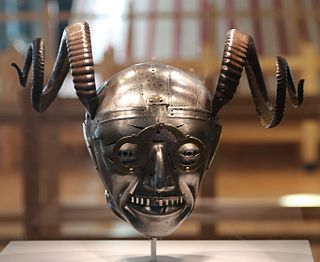
The horned helmet of Henry VIII is the surviving part of a full suit of armour made by Konrad Seusenhofer between 1511 and 1514. The armour was a gift from the Holy Roman Emperor Maximilian I to the English king Henry VIII, following their alliance in the War of the League of Cambrai. The suit was elaborate and intended for display at tournament parades. It is unclear who was the intended wearer of the armour, but it appears to have been modelled on one of Henry's court fools. Henry may have worn the armour as a jest. The helmet has protruding eyes and a toothy grimace and is adorned with horns and spectacles. The helmet survived when the rest of the suit of armour was scrapped, probably after the English Civil War, and it is now in the collection of the Royal Armouries Museum in Leeds, which formerly used it as a symbol of the museum.















